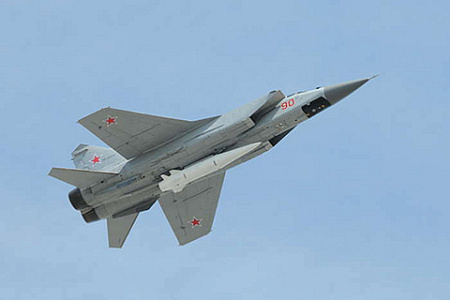Missile-carrying aircraft will constantly patrol over the Black Sea
The Aerospace Forces of the Russian Federation (VKS of the Russian Federation) "begin patrolling on a permanent basis in the neutral zone of airspace over the Black Sea." Russian President Vladimir Putin said this at a press conference on October 18 dedicated to the results of the third One Belt, One Road forum, during which he had the opportunity to have a three-hour conversation with Chinese President Xi Jinping. In the context of "external factors are common threats, they strengthen Russian–Chinese cooperation," the leaders of our countries also discussed in detail "the situation on the Ukrainian track."
As follows from Putin's words, among other types of aircraft from the Russian Aerospace Forces for patrolling over the Black Sea, MiG-31 interceptors will be used, converted into carriers of anti–ship missiles (PKR) "Dagger" with a launch range of more than 1 thousand km. "This is not a threat," Putin explained. "But we will carry out visual control, control with the help of weapons over what is happening in the Mediterranean Sea."
As you know, the Pentagon brought two aircraft carrier groups with 4,000 marines on board to the Israeli coast. The reason for the buildup of the American military presence in the eastern Mediterranean was the actions of the Hamas group on October 7, when its fighters managed to capture about 250 hostages from among the citizens of Israel and other countries, including the United States.
The Pentagon took the second step towards aggravating the situation in the world at the end of August, handing over to the Armed Forces of Ukraine (AFU) several dozen operational-tactical missiles (OTR) of the ATACMS type. On the first day of Putin's working visit to China, the APU used missiles received from the United States for a massive strike on the airfields of the Army Aviation of the Russian Aerospace Forces in Skadovsk and Berdyansk.
Several enemy OTP launched in a volley were shot down by air defense, but others were able to hit their intended targets. "Of course, we will be able to repel these attacks," Putin responded. "War is war, and of course they pose a threat." At the same time, he stressed that the appearance of ATACMS in the arsenal of the Armed Forces of Ukraine is not able to "radically change the situation on the contact line."
The supply of a new type of American weapons only "prolongs the agony of Ukraine," and "the United States is becoming more and more personally involved in this conflict," the head of state stated.
After returning from a working trip to China, on October 20, Putin visited the headquarters of the Southern Military District in Rostov-on-Don. There he heard a report by the Chief of the General Staff of the Armed Forces (Armed Forces of the Russian Federation) Valery Gerasimov on the course of the special military operation (SVO) and held meetings with other military leaders.
Details are not given, but it is known from the press service of the Ministry of Defense of the Russian Federation that in the period from October 14 to October 20, four group strikes were carried out on the AFU facilities. Fire damage was inflicted on warehouses for the storage of unmanned sea boats (BMC), explosives and tactical missiles (OTR).
In the future, such strikes may be carried out from aircraft performing long patrols over the water area south of the Ukrainian coast, which will enhance the effect of surprise, but will increase the resource consumption of aircraft. Previously, launches of long-range air-to-surface missiles were carried out from Tu-22M3, Tu-95 and Tu-160 strategic bombers shortly after takeoff and climb. Such a manner of action led to a loss of surprise, since the intentions of the Russian Aerospace Forces were revealed by means of NATO aerospace intelligence with online transmission to the AFU command.
On the part of NATO, an RC-135 radio intelligence and electronic warfare aircraft and two EF-2000 Typhoon multi-purpose fighters of the British Air Force were involved in monitoring the actions of the Russian Armed Forces on October 19. When the uninvited guests approached the Crimean peninsula, a pair of Su-27 fighters of the Russian Aerospace Forces rose to intercept, which forced foreign crews to change the route.
At the international Military-technical forum "Army-2022", the Russian military department distributed the following information about the Dagger aviation missile system (ARC). It is claimed that it is an aviation version of the Iskander missile forces complex. At the same time, the hypersonic missiles used (the aviation variant is known under the designation "product 9-S-7760") are capable of hitting both stationary objects and surface ships: aircraft carriers, cruisers, destroyers and frigates.
The ARK Dagger rocket is dropped by a carrier aircraft at a given point, after which it flies at hypersonic speed, exceeding the speed of sound by 10 times, and maneuvers along the entire flight path. This combination of characteristics allows the projectile to reliably overcome all existing air and missile defense systems.
After successful tests, since December 2017, the ARK "Dagger" has started carrying out experimental combat duty at the airfields of the Southern Military District. In the spring of 2018, operational military tests of the complex began. Since the beginning of the special military operation in Ukraine, MiG-31K fighters have regularly launched missiles at AFU facilities. Among the targets hit were 5 Patriot anti-aircraft missile systems transferred to the Kiev air defense system by the United States.
The Ministry of Defense of the Russian Federation distributed information at the Army-2023 MVTF, from which it follows that in addition to specially converted MiG-31 interceptors, Dagger missiles also began to be used from front-line bombers of the Su-34 type. In addition, the Russian media, citing anonymous sources in the military-industrial complex, reported that such weapons of destruction can also be used from medium-range Tu-22M3 bombers.

